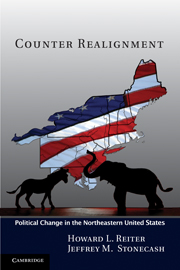Book contents
- Frontmatter
- Contents
- List of Figures
- List of Tables
- Preface
- Acknowledgments
- Postscript: Democratic Fortunes in the Northeast in 2010
- 1 Party Strategies and Transition in the Northeast
- 2 Party Pursuits and the Sources of Change
- 3 The First Republican Losses
- 4 Searching for a Majority, the Rise of Conservatives, and Second Losses
- 5 Interpreting the Goldwater Election and Pursuing the South
- 6 Social Change, Party Response, and Further Republican Losses
- 7 National Parties and the Position of the Northeast
- 8 The Process of Change and the Future
- Index
- References
6 - Social Change, Party Response, and Further Republican Losses
Published online by Cambridge University Press: 05 June 2012
- Frontmatter
- Contents
- List of Figures
- List of Tables
- Preface
- Acknowledgments
- Postscript: Democratic Fortunes in the Northeast in 2010
- 1 Party Strategies and Transition in the Northeast
- 2 Party Pursuits and the Sources of Change
- 3 The First Republican Losses
- 4 Searching for a Majority, the Rise of Conservatives, and Second Losses
- 5 Interpreting the Goldwater Election and Pursuing the South
- 6 Social Change, Party Response, and Further Republican Losses
- 7 National Parties and the Position of the Northeast
- 8 The Process of Change and the Future
- Index
- References
Summary
As the 1970s began, the situation of the national Republican Party was decidedly mixed. Richard Nixon won re-election by a large margin in 1972, giving the party two presidents winning consecutive terms within twenty years. In that election, the party gained 12 seats in the House, bringing their total to 192. In the Senate, the party won 17 of the 33 seats up for election. Despite this good news, the difficulties the party faced were significant. It was in the minority in each house of Congress. The percentage of respondents identifying with the Republican Party was not increasing. The party image presented by Nixon was muddled. On the one hand, he proposed the guaranteed income tax; on the other hand, he made it clear that he would not be aggressive in pursuing civil rights cases or busing. In the 1972 campaign, he pursued Wallace voters and created an electoral coalition comprised of his 1968 vote plus many of Wallace's supporters. The party was making gains in winning congressional seats in the South but not fast enough to become solidly conservative and rely on southern seats.
For the Northeast, Nixon's position of expressing sympathy for the South and pursuing a southern strategy created problems because many in the Northeast were uncomfortable with policies that supported resistance to civil rights. While Nixon did well in the Northeast in 1972, his support did not translate into greater support for House candidates.
- Type
- Chapter
- Information
- Counter RealignmentPolitical Change in the Northeastern United States, pp. 101 - 146Publisher: Cambridge University PressPrint publication year: 2011



